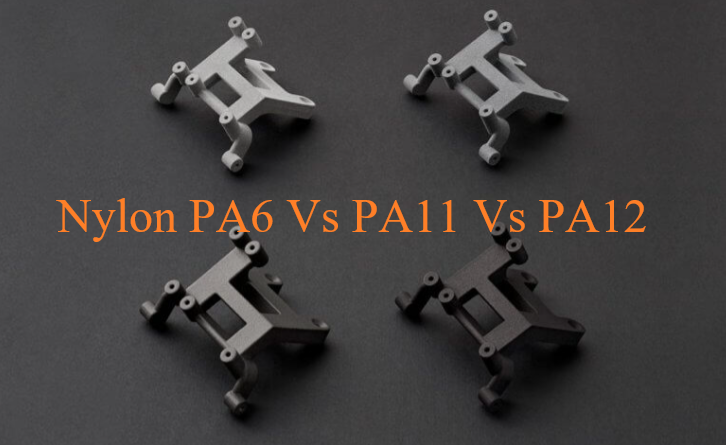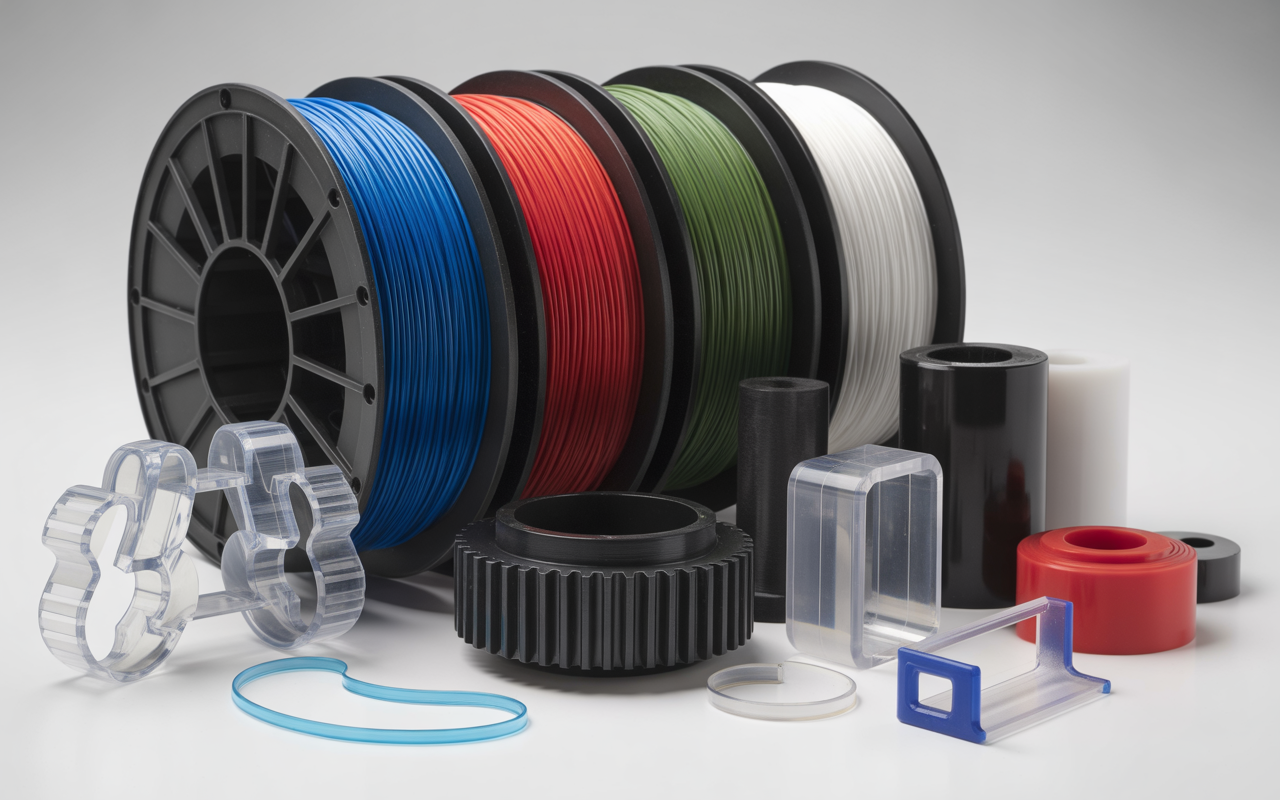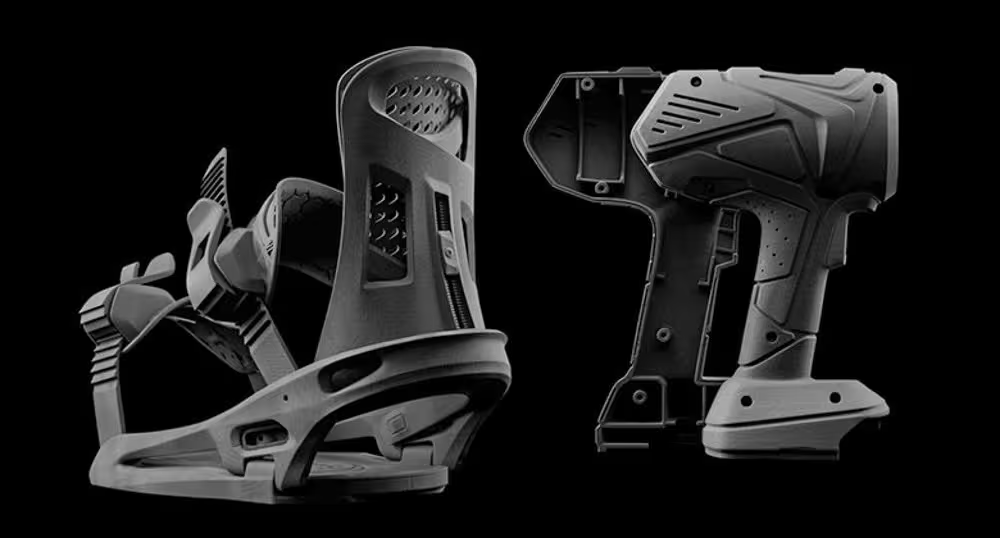Nylon, known in the technical world as polyamide (PA), is the earliest man-made material and one of the most widely used plastics. It covers almost all aspects of life. From wear to use, it is a material with comprehensive properties. Nylon itself is a semi crystalline, thermoplastic material with low melting point and good fluidity, making nylon an ideal 3D printing material. Nylon is mainly divided into eight types: PA6, PA66, PA46, PA69, PA610, PA612, PA11, and PA12. At present, PA12 is the main nylon that can be 3D printed on the market, and PA11 and PA6 are also available. What are the differences and connections between PA12, PA11, and PA6 for 3D printing? And which Nylon filament is best for 3D printing? Today CNCLATHING will take you to sort out these nylon materials for 3D printing.

Nylon PA6 Vs PA11 Vs PA12 For 3D Printing – What’s The Difference Between PA6, PA11 and PA12 Filament?
Nylon’s appeal for 3D printing comes down to its unique mix of strength, toughness, wear resistance, and flexibility. Parts printed with nylon can withstand repeated stress and strain, making them ideal for both prototyping and end-use applications. Its chemical resistance ensures durability in harsh environments, while good dimensional stability means printed parts maintain their shape over time. These qualities make nylon suitable for everything from automotive components and tooling to consumer products and medical devices.
Among nylons, PA6, PA11, and PA12 are the most widely used in 3D printing. Each has evolved to meet specific mechanical, thermal, and practical demands across various 3D printing technologies, including Fused Filament Fabrication (FFF), Selective Laser Sintering (SLS), and Multi Jet Fusion (MJF).
1. What is Nylon PA6?
PA6, or Nylon 6, is a synthetic polymer well-known for its high strength, toughness, and impact resistance. It’s one of the most popular engineering nylons and has been widely adopted in both injection molding and 3D printing.
The most common nylon materials in industry and life are PA6 and PA66, which are short chain synthetic materials. The strength, temperature resistance, aesthetics and corrosion resistance of the materials are excellent. The crystallinity of PA6 is not as good as PA66, the melting point is slightly lower, the toughness is slightly stronger, and the processability is slightly better. The difference between the two is not great. Unfortunately, due to the high moisture absorption (1.5% – 2.8%), the 3D printability of these two nylon materials is not very good.
Nylon PA6 Filament Temperature
- Extrusion/Printing Temperature:
220°C – 280°C (428°F – 536°F)
This is the typical melt temperature range for PA6 (Nylon 6) filament. Printing at the lower end may be possible on some machines, but higher temperatures (closer to 260°C–270°C) are common for better layer adhesion and flow, especially for reinforced grades. - Bed Temperature:
60°C – 90°C (140°F – 194°F)
Helps reduce warping and ensures proper adhesion to the build surface. - Drying:
PA6 is highly hygroscopic and must be very dry before printing. Dry at 80°C – 90°C for at least 4–8 hours before use.
PA6 warps easily and absorbs more moisture than PA12 or PA11. Use an enclosure if possible and print from a dry box for best results.
Nylon PA6 Properties & Uses
- Mechanical Strength: PA6 offers excellent rigidity and impact resistance, making it suitable for applications where parts will be subjected to mechanical stress.
- Heat Resistance: It can withstand higher operating temperatures, typically up to around 190°C.
- Moisture Sensitivity: PA6 absorbs moisture readily, up to 3% of its weight, which can affect its mechanical properties and print quality. This high moisture uptake can lead to warping, dimensional changes, and loss of strength over time if not properly dried.
- Printability: While PA6 delivers superb strength, it is prone to warping and can be challenging to print, especially for large parts or open-frame printers.
Carbon and glass fiber reinforced versions of PA6, such as PA6-CF and PA6-GF, improve stiffness, reduce warping, and offer enhanced dimensional stability, but moisture sensitivity remains a concern.
2. What is Nylon PA11?
PA11, or Nylon 11, is a bio-based polyamide derived from castor oil. While less common than PA6 and PA12, it occupies a unique position in 3D printing due to its combination of mechanical strength, flexibility, and chemical resistance.
Nylon PA12 is the most common 3D printing material. PA12 is developed to replace most of the functions of PA11, so most of its properties are consistent. It belongs to long-chain nylon (12 or 11 carbon chain), with good mechanical properties and electrical insulation. It is widely used in pipes, shells, complex assembly, connectors and other parts. PA11 is more expensive. PA11 is prepared from castor oil and PA12 is prepared from oil. From the perspective of environmental friendliness, PA11 is undoubtedly more green and sustainable and uses renewable biological resources, but the raw material price of PA11 is more than three times that of PA12. In addition to being more expensive, PA11 has the advantage of better high and low temperature performance. The melting point is 10 degrees higher than PA12, reaching 200 degrees, and the working temperature is slightly higher than that of nylon 12 + glass fiber. At low temperature, the flexibility of PA11 is significantly stronger than that of PA12.
Nylon PA11 Filament Temperature
- Extrusion/Printing Temperature:
220°C – 260°C (428°F – 500°F)
PA11 (Nylon 11) prints at temperatures similar to PA6, but can sometimes be printed slightly lower. Check the filament manufacturer’s recommendations. - Bed Temperature:
60°C – 90°C (140°F – 194°F)
Similar to PA6, a heated bed reduces warping. - Drying:
Less hygroscopic than PA6 but still requires drying. Dry at 80°C – 90°C for 4–8 hours before printing.
PA11 is bio-based, offers better flexibility and impact resistance compared to PA6 and PA12, and absorbs less moisture than PA6.
Nylon PA11 Properties & Uses
- Toughness and Flexibility: PA11 is known for being both rigid and tough, offering excellent impact resistance with a touch more flexibility than PA12. This makes it ideal for parts that must absorb shock or flex during use.
- Temperature Resistance: The melting point is around 197°C, and it maintains mechanical properties across a wide temperature range.
- Chemical and UV Resistance: PA11 stands out for its ability to resist chemicals and UV exposure, making it suitable for outdoor or chemically aggressive environments.
- Moisture Resistance: It absorbs less moisture than PA6, improving dimensional stability and predictability.
- SLS & Industrial Applications: PA11 is widely used in SLS 3D printing for high-performance parts, including automotive, aerospace, medical, and drone components, where lightweight and rigidity are desirable.
3. What is Nylon PA12?
PA12, or Nylon 12, is another popular polyamide, notable for its exceptional printability and moisture resistance. It’s the standard for many SLS and MJF applications and increasingly popular in FFF, especially with carbon or glass fiber reinforcement.
An important difference between PA12 and PA11 and PA6 (6) is moisture absorption. The moisture absorption of PA11 and PA12 is only 0.25%, which is 10 times less than that of PA6 / PA66, making them easier 3D printing materials. SLS and FDM processes are sensitive to moisture absorption and shrinkage. The performance of PA12 and PA11 is between PA6 and PE, and the toughness is better than PA6 (6). In some applications, such as wires, PA6 (6) may be too hard, while PA12 and PA11 are competent. However, PA12 and PA11 have lower melting temperature, lower strength, lower dielectric properties and more expensive price, which is also the main reason why PA12 is not widely used as PA6 in actual industrial production.
Nylon PA12 Filament Temperature
- Extrusion/Printing Temperature:
245°C – 270°C (473°F – 518°F)
Typical range for extrusion-based (FFF/FDM) 3D printing. For SLS (powder bed), the melting point is ~176°C (349°F), with chamber temperatures kept slightly below this. - Bed Temperature:
70°C – 90°C (158°F – 194°F)
Higher bed temperatures further reduce warping and improve adhesion. - Drying:
PA12 is much less hygroscopic than PA6 or PA11, but drying is still recommended for best results: 80°C – 90°C for 4–8 hours.
PA12 is prized for its moisture stability, dimensional accuracy, and ease of printing. It warps less and absorbs much less water (as little as 0.5% by mass) compared to PA6 (up to 3%). PA12 is also slightly more flexible and has a lower melting point than PA6. It is ideal for large, complex, or long print jobs, and is widely used in automotive and aerospace applications.
Nylon PA12 Properties & Uses
- Dimensional Stability: PA12 absorbs significantly less moisture than PA6 (typically around 0.5%-1.5%), resulting in parts that retain their shape and mechanical properties even in humid conditions.
- Printability: It warps less than PA6, making it easier to print reliably, especially for large or intricate parts. Users report successful overnight prints with minimal supervision.
- Flexibility and Strength: PA12 is slightly more flexible than PA6, which can be advantageous for certain applications. Its tensile and flexural strengths are still high, and it resists cracking under stress.
- Temperature Resistance: It has a melting point around 176°C, lower than PA6 and PA11, but still adequate for most engineering applications.
- Surface Quality: PA12 delivers smooth finishes and is easy to post-process. It’s the material of choice for functional prototypes, end-use parts, and detailed models requiring excellent surface quality.
- Chemical Resistance: It withstands exposure to oils, greases, hydrocarbons, and alkalis.
- Industrial Use: PA12 is widely used in automotive, motorsports (e.g., McLaren F1), aerospace, and consumer products, thanks to its reliability and performance.
4. PA6 vs PA11 vs PA12: What is the Difference?
Despite their shared polyamide family, PA6, PA11, and PA12 each offer distinct characteristics:
| Properties | PA6 (Nylon 6) | PA11 (Nylon 11) | PA12 (Nylon 12) |
|---|---|---|---|
| Source | Petroleum-based | Bio-based (castor oil) | Petroleum-based |
| Moisture Absorption | High (~3% by weight) | Low to moderate (~1-1.5%) | Very low (~0.5-1.5%) |
| Dimensional Stability | Fair (can change with humidity) | Good | Excellent |
| Rigidity | Very rigid | Rigid with some flexibility | Rigid but more flexible than PA6 |
| Impact Resistance | High | Very high | High |
| Toughness | Excellent | Excellent | Very good |
| Flexibility | Moderate | Higher than PA6/PA12 | Higher than PA6 |
| Heat Resistance | Up to ~190°C | Up to ~170-190°C | Up to ~176°C |
| Printability | More challenging; prone to warping | Good (SLS); complex geometries | Easiest; low warping |
| Layer Adhesion | Good (can be affected by moisture) | Excellent (especially in SLS) | Excellent |
| Chemical Resistance | Good | Excellent | Excellent |
| UV Resistance | Moderate | Excellent | Very good |
| Cost | Lower | Higher (most expensive) | Higher than PA6, less than PA11 |
| Best Applications | Jigs, fixtures, impact parts | Automotive, aerospace, medical, SLS | Production parts, large prints, functional prototypes |
| 3D Printing Methods | FFF, SLS (with care) | SLS | FFF, SLS, MJF |
| Typical Reinforcement | Glass/carbon fiber | Carbon fiber (for added strength) | Glass/carbon fiber |
How Do You Compare Nylon Materials For 3D Printing?
Comparison of PA66 Vs PA6:
– The dilution ratio is slightly lower
– Higher modulus
– Better wear resistance
– Better short-term heat resistance
Comparison of PA6 Vs PA66:
– Better ductility (due to higher toughness)
– Better long-term heat resistance
– Better impact resistance at low temperature
– Better surface quality
– Better creep resistance
– Better UV resistance linearity (depending on modification)
– Lower cost
Comparison of PA11 Vs PA12:
– Reasonable UV resistance linearity (compared with other nylon, not only PA 12)
– Higher strength
– Better heat resistance
– More green and environmental protection
– Less renewable resources are consumed in the production process
Comparison of PA12 Vs PA66
– More expensive
– Low impact strength.
– Lower operating temperature
5. PA6 vs PA11 vs PA12: Which Nylon is Best for 3D Printing?
Choosing the best nylon depends on your specific application needs:
- Choose PA6 if you need top-tier temperature resistance, rigidity, and impact strength. It’s the right call for high-stress components, jigs, fixtures, and parts that will take a beating. However, be mindful of its moisture sensitivity—drying and annealing are recommended.
- Choose PA12 if you value dimensional stability, low moisture absorption, and easy, reliable printing. It’s the preferred material for functional parts, large prints, or when minimal warping and consistent mechanical properties are crucial. PA12 is also ideal for production environments, print farms, and applications where parts must maintain their properties over time.
- Choose PA11 if your part needs a blend of toughness and flexibility, exceptional impact resistance, and resistance to chemical or UV exposure. It’s a strong choice for SLS printing, especially in automotive, aerospace, and medical industries.
PA6 excels in strength and heat resistance, PA12 wins for printability and stability, and PA11 offers a balance of toughness, flexibility, and environmental resilience. Each nylon has its place in 3D printing, learning their strengths and limitations ensures you get the most out of your materials and your printer.







